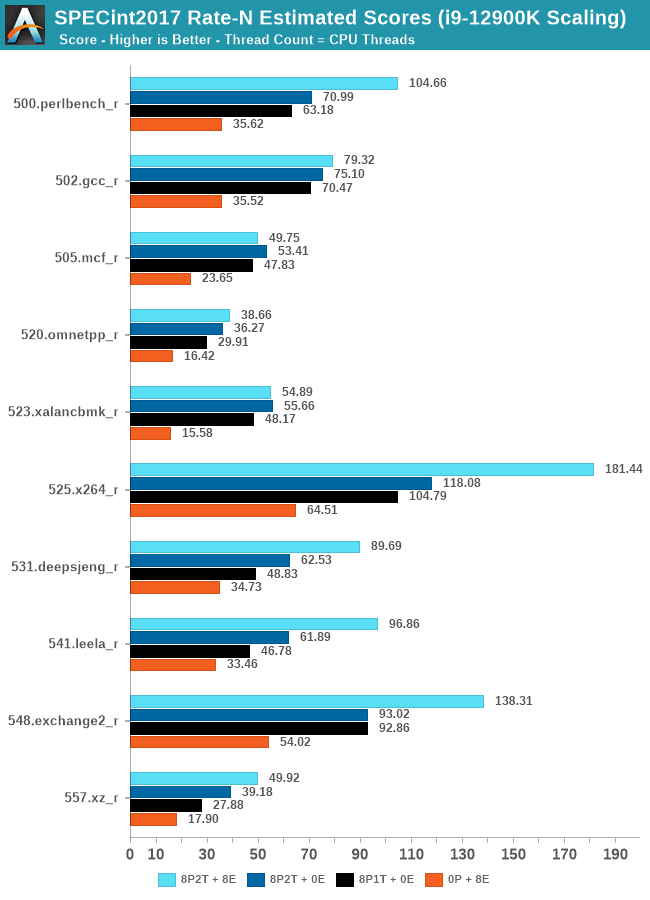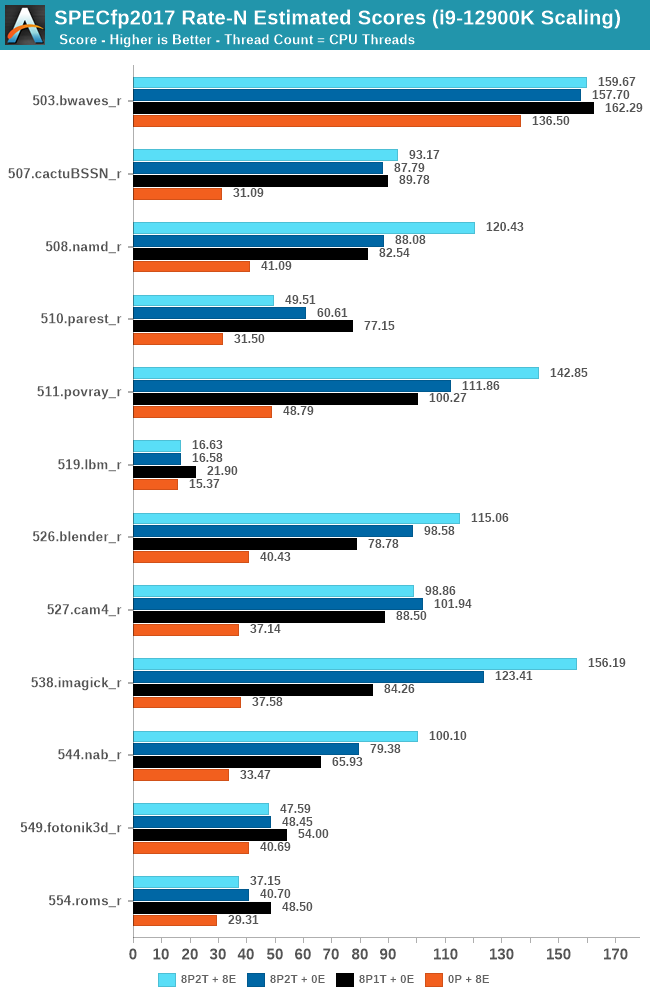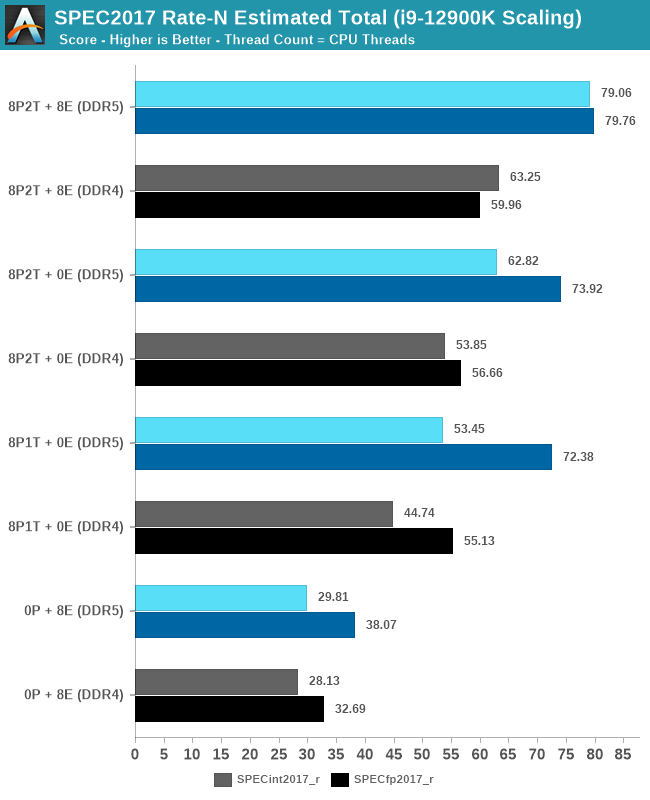The Intel 12th Gen Core i9-12900K Review: Hybrid Performance Brings Hybrid Complexity
by Dr. Ian Cutress & Andrei Frumusanu on November 4, 2021 9:00 AM ESTCPU Tests: SPEC MT Performance - P and E-Core Scaling
Update Nov 6th:
We’ve finished our MT breakdown for the platform, investigating the various combination of cores and memory configurations for Alder Lake and the i9-12900K. We're posting the detailed scores for the DDR5 results, following up the aggregate results for DDR4 as well.
The results here solely cover the i9-12900K and various combinations of MT performance, such as 8 E-cores, 8 P-cores with 1T as well as 2T, and the full 24T 8P2T+8E scenario. The results here were done on Linux due to easier way to set affinities to the various cores, and they’re not completely comparable to the WSL results on the previous page, however should be within small margins of error for most tests.

In the integer suite, the E-cores are quite powerful, reaching scores of around 50% of the 8P2T results, or more.
Many of the more core-bound workloads appear to very much enjoy just having more cores added to the suite, and these are also the workloads that have the largest gains in terms of gaining performance when we add 8 E-cores on top of the 8P2T results.
Workloads that are more cache-heavy, or rely on memory bandwidth, both shared resources on the chip, don’t scale too well at the top-end of things when adding the 8 E-cores. Most surprising to me was the 502.gcc_r result which barely saw any improvement with the added 8 E-cores.
More memory-bound workloads such as 520.omnetpp or 505.mcf are not surprising to see them not scale with the added E-cores – mcf even seeing a performance regression as the added cores mean more memory contention on the L3 and memory controllers.

In the FP suite, the E-cores more clearly showcase a lower % of performance relative to the P-cores, and this makes sense given their design. Only few more compute-bound tests, such as 508.namd, 511.povray, or 538.imagick see larger contributions of the E-cores when they’re added in on top of the P-cores.
The FP suite also has a lot more memory-hungry workload. When it comes to DRAM bandwidth, having either E-cores or P-cores doesn’t matter much for the workload, as it’s the memory which is bottlenecked. Here, the E-cores are able to achieve extremely large performance figures compared to the P-cores. 503.bwaves and 519.lbm for example are pure DRAM bandwidth limited, and using the E-cores in MT scenarios allows for similar performance to the P-cores, however at only 35-40W package power, versus 110-125W for the P-cores result set.
Some of these workloads also see regressions in performance when adding in more cores or threads, as it just means more memory traffic contention on the chip, such as seen in the 8P2T+8E, 8P2T regressions over the 8P1T results.

What’s most interesting here is the scaling of performance and the attribution between the P-cores and the E-cores. Focusing on the DDR5 set, the 8 E-cores are able to provide around 52-55% of the performance of 8 P-cores without SMT, and 47-51% of the P-cores with SMT. At first glance this could be argued that the 8P+8E setup can be somewhat similar to a 12P setup in MT performance, however the combined performance of both clusters only raises the MT scores by respectively 25% in the integer suite, and 5% in the FP suite, as we are hitting near package power limits with just 8P2T, and there’s diminishing returns on performance given the shared L3. What the E-cores do seem to allow the system is to allows to reduce every-day average power usage and increase the efficiency of the socket, as less P-cores need to be active at any one time.










474 Comments
View All Comments
Spunjji - Friday, November 5, 2021 - link
I thought much the same.blanarahul - Thursday, November 4, 2021 - link
"ArsTechnica gave a bit more info in that regard, and Alder Lake looks terrible on performance/watt."I was suspicious that this is the reason Intel finally went hybrid on mainstream. Golden Cove can have horrible perf/watt since Gracemont exists for low power scenarios.
Maxiking - Thursday, November 4, 2021 - link
listening to arse technica in 2k21 lolmichael2k - Thursday, November 4, 2021 - link
It's data. Do you just discount data?The Garden Variety - Thursday, November 4, 2021 - link
Well, you at least have to appreciate that Maxiking saved significant time and effort by typing "2k21" instead of "2021". Attention to efficiency is something we can all respect and admire in MMXXI.m53 - Thursday, November 4, 2021 - link
[Intel 12th gen consumes less power in gaming across the board vs Ryzen 5000 series](https://www.reddit.com/r/intel/comments/qmw9fl/why... [Even the Multi threaded perf per watt is also better for 12900K compared to 5900X](https://twitter.com/capframex/status/1456244849477... It is only specific cases where 12900k need to beat 5950x in multi threaded loads it needs to crank up more power. But for typical users Intel is both the perf /watt and perf /dollar champion.Bobbyjones - Thursday, November 4, 2021 - link
Until you look at the gaming power consumption and realize Intel is beating AMD in efficiency in games and general use. Check igorslab's review. Its only in the highly threaded workstation applications like blender or synthetics that use 100% of load that Intel starts using quite a bit of power. But 99% of users will never do those, all they care about is gaming, browsing, video, etc.Blastdoor - Thursday, November 4, 2021 - link
So if 99% of users don’t need multiple cores, I guess intel made a huge mistake in including them. They could have just made a dual core processor and “99%” of users would have been just fine.I think it’s HILARIOUS that people are arguing that the efficiency of this thing is just fine so long as you don’t actually fully utilize it.
Hulk - Thursday, November 4, 2021 - link
You mean like how I can drive my Civic in a sane manner and get 40mpg or hammer it and get 20mpg? Push the CPU (or automobile) out of it's efficient zone and it becomes less efficient. You can do the same thing with Zen 3 CPU's. They get a little faster and use a lot more power. Same as Intel CPU's.jerrylzy - Friday, November 5, 2021 - link
12900K is no Civic. More like a Ferrari. If you never push that Ferrari, why buy it? Buy a Civic then (12600)?